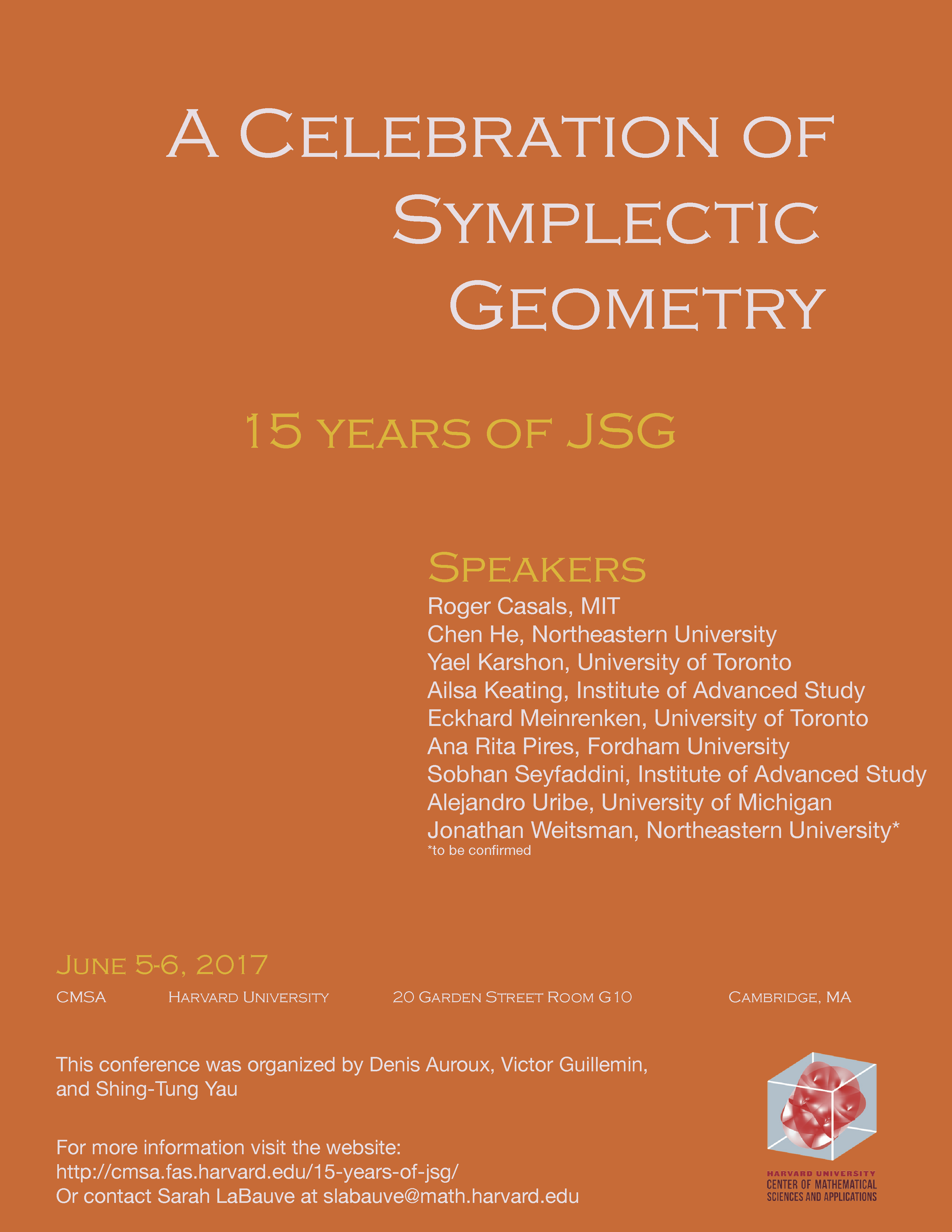
- This event has passed.
A Celebration of Symplectic Geometry: 15 Years of JSG

In celebration of the Journal of Symplectic Geometry’s 15th anniversary, the Center of Mathematical Sciences and Applications will be hosting A Celebration of Symplectic Geometry: 15 Years of JSG on June 5-6, 2017.
Confirmed speakers:
- Roger Casals, MIT
- Chen He, Northeastern University
- Yael Karshon, University of Toronto
- Ailsa Keating, Institute of Advanced Study
- Eckhard Meinrenken, University of Toronto
- Ana Rita Pires, Fordham University
- Sobhan Seyfaddini, Institute of Advanced Study
- Alejandro Uribe, University of Michigan
- Jonathan Weitsman, Northeastern University
The conference is co-organized by Denis Auroux and Victor Guillemin. Additional information on the conference will be announced closer to the event.
Schedule:
June 5, Monday (Full day)
| Time | Speaker | Topic |
| 8:30am – 9:0am | Breakfast | |
| 9:00am – 10:00am | Jonathan Weitsman | Title: On the geometric quantization of (some) Poisson manifolds |
| 10:30am – 11:30am | Eckhard Meinrenken | Title: On Hamiltonian loop group spaces
Abstract: Let G be a compact Lie group. We explain a construction of an LG-equivariant spinor module over any Hamiltonian loop group space with proper moment map. It may be regarded as its `canonical spin-c structure’. We show how to reduce to finite dimensions, resulting in actual spin-s structure on transversals, as well as twisted spin-c structures for the associated quasi-hamiltonian space. This is based on joint work with Yiannis Loizides and Yanli Song. |
| 11:30am – 1:30pm | Break | |
| 1:30pm – 2:30pm | Ana Rita Pires | Title: Infinite staircases in symplectic embedding problems
Abstract: McDuff and Schlenk studied an embedding capacity function, which describes when a 4-dimensional ellipsoid can symplectically embed into a 4-ball. The graph of this function includes an infinite staircase related to the odd index Fibonacci numbers. Infinite staircases have been shown to exist also in the graphs of the embedding capacity functions when the target manifold is a polydisk or the ellipsoid E(2,3). I will describe how we use ECH capacities, lattice point counts and Ehrhart theory to show that infinite staircases exist for these and a few other target manifolds, as well as to conjecture that these are the only such target manifolds. This is a joint work with Cristofaro-Gardiner, Holm and Mandini. |
| 3:00pm – 4:00pm | Sobhan Seyfaddini | Title: Rigidity of conjugacy classes in groups of area-preserving homeomorphisms
Abstract: Motivated by understanding the algebraic structure of groups of area-preserving homeomorphims F. Beguin, S. Crvoisier, and F. Le Roux were lead to the following question: Can the conjugacy class of a Hamiltonian homeomorphism be dense? We will show that one can rule out existence of dense conjugacy classes by simply counting fixed points. This is joint work with Le Roux and Viterbo. |
| 4:30pm – 5:30pm | Roger Casals | Title: Differential Algebra of Cubic Graphs Abstract: In this talk we will associate a combinatorial dg-algebra to a cubic planar graph. This algebra is defined by counting binary sequences, which we introduce, and we shall provide explicit computations and examples. From there we study the Legendrian surfaces behind these constructions, including Legendrian surgeries, the count of Morse flow trees involved in contact homology, and the relation to microlocal sheaves. Time permitting, I will explain a connection to spectral networks.Video |
June 6, Tuesday (Full day)
| Time | Speaker | Topic |
| 8:30am – 9:00am | Breakfast | |
| 9:00am – 10:00am | Alejandro Uribe | Title: Semi-classical wave functions associated with isotropic submanifolds of phase space
Abstract: After reviewing fundamental ideas on the quantum-classical correspondence, I will describe how to associate spaces of semi-classical wave functions to isotropic submanifolds of phase space satisfying a Bohr-Sommerfeld condition. Such functions have symbols that are symplectic spinors, and they satisfy a symbol calculus under the action of quantum observables. This is the semi-classical version of the Hermite distributions of Boutet the Monvel and Guillemin, and it is joint work with Victor Guillemin and Zuoqin Wang. I will inlcude applications and open questions. |
| 10:30am – 11:30am | Alisa Keating | Title: Symplectomorphisms of exotic discs
Abstract: It is a theorem of Gromov that the group of compactly supported symplectomorphisms of R^4, equipped with the standard symplectic form, is contractible. While nothing is known in higher dimensions for the standard symplectic form, we show that for some exotic symplectic forms on R^{4n}, for all but finitely n, there exist compactly supported symplectomorphisms that are smoothly non-trivial. The principal ingredients are constructions of Milnor and Munkres, a symplectic and contact version of the Gromoll filtration, and Borman, Eliashberg and Murphy’s work on existence of over-twisted contact structures. Joint work with Roger Casals and Ivan Smith. |
| 11:30am – 1:30pm | Break | |
| 1:30pm – 2:30pm | Chen He | Title: Morse theory on b-symplectic manifolds
Abstract: b-symplectic (or log-symplectic) manifolds are Poisson manifolds equipped with symplectic forms of logarithmic singularity. Following Guillemin, Miranda, Pires and Scott’s introduction of Hamiltonian group actions on b-symplectic manifolds, we will survey those classical results of Hamiltonian geometry to the b-symplectic case. |
| 3:00pm – 4:00pm | Yael Karshon | Title: Geometric quantization with metaplectic-c structures
Abstract: I will present a variant of the Kostant-Souriau geometric quantization procedure that uses metaplectic-c structures to incorporate the “half form correction” into the prequantization stage. This goes back to the late 1970s but it is not widely known and it has the potential to generalize and improve upon recent works on geometric quantization. |
